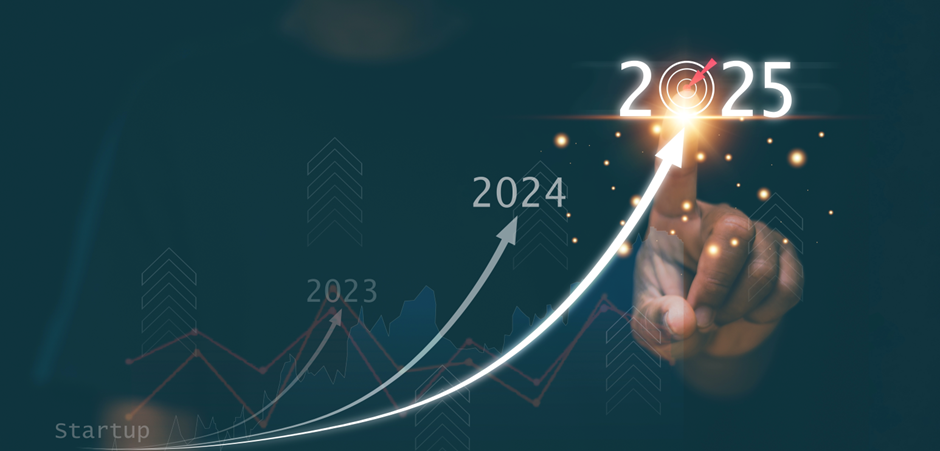The last financial year wasn’t defined by one big trend, but by a series of pressure points that reshaped how IT leaders think about strategy. Between economic caution, an explosion of AI interest, and a relentless cadence of security breaches, many organisations hit pause on bold bets and focused instead on building safer, smarter foundations.
At The Missing Link, we’ve had hundreds of conversations with transformation leaders across industries. One theme keeps surfacing: the need to move from reactive execution to deliberate, insight-driven planning.
FY26 isn’t about catching up, it’s about using what we’ve learned to sharpen strategies, close the maturity gap, and align IT decisions with business impact.
In this article, we unpack the trends, tensions and opportunities shaping FY26 and where the most forward-thinking leaders are focusing their energy next.

What FY25 taught us
If there’s one word that summed up FY25 for many IT leaders, it was pressure. Not just to keep operations running or respond to threats but to deliver tangible outcomes in an environment where expectations outpaced resourcing. From boardrooms to back-end systems, the gap between ambition and readiness became more visible.
So where are organisations heading now? The trends emerging from FY25 show a clear shift from experimentation to execution, from siloed efforts to integrated outcomes, and from technical fixes to enterprise-wide enablement. These lessons are already shaping how leaders are recalibrating their strategies across key domains.
Trend #1: Buyers are consolidating and rationalising security tools
In FY25, many teams encountered challenges due to rapid tool adoption, leading to complex and overlapping systems that hindered visibility and increased risk.
This has prompted a shift towards consolidation, with IT and security leaders streamlining their vendor portfolios and prioritising integrated platforms.
- Managed Security Services (MSS): The Australian MSS market reached AUD 1.5 billion in 2024 and is projected to grow at a CAGR of 12.2% from 2025 to 2033, driven by the need for 24/7 threat monitoring and advanced threat detection capabilities.
- Zero Trust Adoption: The Zero Trust security market in Australia was valued at AUD 1.04 billion in 2024 and is expected to reach AUD 2.4 billion by 2030, growing at a CAGR of 20.6% from 2025 to 2030. This growth reflects the increasing emphasis on identity verification and access management.
Trend #2: Cloud spending is getting smarter, not bigger
In FY25, Australian organisations continued to embrace cloud services, with public cloud end-user spending projected to reach AUD 26.6 billion in 2025 - a rise of 18.9% from the previous year. However, this growth is accompanied by increased scrutiny over cloud expenditures and a shift towards more strategic utilisation.
The focus is moving from expansive adoption to optimised usage. Organisations are prioritising:
- Governance Reviews: Implementing structured policies to manage cloud resources effectively.
- Misconfiguration Clean-ups: Addressing security risks arising from improper configurations, which are a leading cause of cloud breaches.
- Cost Visibility Tools: Adopting solutions that provide real-time insights into cloud spending, aiding in budget adherence and financial planning.
This strategic approach ensures that cloud investments deliver maximum value, aligning with organisational goals and regulatory requirements.
Trend #3: AI readiness is the real priority
In FY25, artificial intelligence made its way from innovation teams into the C-suite agenda, driven by the buzz around generative AI. But enthusiasm hasn’t yet translated into widespread impact.
Across Australia, organisations are still grappling with the foundational work required to operationalise AI safely and effectively. While 63% of Australian enterprises report exploring generative AI, only 8% have fully integrated it into operations. Among SMEs, adoption has risen to 41%, yet 1 in 5 still don’t know how to leverage AI in a meaningful way.
What’s holding them back? We’re seeing common blockers such as:
- Poor data governance and fragmented architecture
- Unclear business use cases or ROI models
- Security and IP protection concerns
- Lack of cross-functional capability or executive alignment
Trend #4: Human risk is still underrated
Human error remains a significant vulnerability in cybersecurity. In FY25, Australian organisations continued to grapple with challenges such as phishing attacks, access mismanagement, and poor endpoint hygiene.
The Verizon Data Breach Investigations Report revealed that 68% of breaches involved the human element, including errors, social engineering, and misuse of privileges.
A 2024 report by Arctic Wolf revealed that 67% of IT leaders and end-users in Australia and New Zealand admitted to reusing system passwords, highlighting a widespread issue with password management.
These issues underscore the persistent nature of human-related risks in the digital landscape.
Trend #5: Resilience is replacing compliance as the end goal
In FY25, compliance benchmarks like ISO 27001 or the ASD Essential 8 were no longer seen as endpoints, they became baselines. What stood out was a shift in executive mindset: it’s no longer just about being compliant, it’s about proving you can bounce back fast.
Across sectors, we saw a sharp uptick in board-level interest around incident readiness. Organisations are asking tougher questions: Can we detect and respond fast enough? Can we keep the business running? What does worst-case recovery actually look like?
What was observed:
- More businesses engaging in continuity and resilience workshops
- Growing interest in incident response retainers and DR testing
- Auditors pushing beyond checklist compliance, probing for operational proof points
 Where strategic leaders are focused
Where strategic leaders are focused
In FY26, strategic IT leaders are stepping beyond siloed tech execution and embedding transformation into the core of how their organisations operate.
Smart leaders are moving beyond pilots and investing in readiness assessments, governance frameworks, and workforce education to build maturity before scale.
Here’s what is defining the forward-looking leader right now:
- Governance-first thinking: Whether it’s AI, cybersecurity, or cloud, the best-run programs are guided by clear governance frameworks. These leaders are putting structure around decision-making, accountability, and risk, not just tech deployment.
Our IT Strategy Reviews and Maturity Assessments help leaders formalise decision-making, clarify risk ownership, and align IT efforts with business priorities.
- Integrated transformation roadmaps: Rather than treating AI, security and cloud as separate streams, building unified roadmaps that align these priorities with business goals and dependencies. That’s how you avoid fragmentation and maximise ROI.
Our AI Strategy and Cloud Migration Planning engagements are designed to break down silos and support cohesive digital execution.
- People-first enablement: The most powerful tech still needs human buy-in, alignment and capability to make it work. Strategic leaders are investing in upskilling, change readiness and cross-functional collaboration as critical enablers of IT maturity and digital momentum.
From Cyber Awareness Training to IT Consulting, we support capability uplift that ensures transformation sticks and staff are equipped to deliver securely and effectively.
The common thread? A shift from reactive execution to proactive orchestration. These are the moves that build resilience, earn board trust, and deliver sustainable impact.
Don’t Just Plan. Adapt Intelligently.
FY26 offers a rare chance to reframe your approach, to move from lessons to leadership. At The Missing Link, we help organisations convert insight into advantage through focused strategy, assessment, and enablement.
Ready to turn insight into advantage? Let’s talk.


 Where strategic leaders are focused
Where strategic leaders are focused